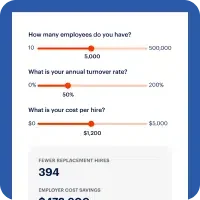Education Series Module 4: The Employee Experience: Solution, Rollout, and Support
The Employee Experience: Solution, Rollout, and Support
Making sure your people get the most benefit from on-demand pay.
Ready to get started with on-demand pay?
At a Glance
When considering different vendors for your on-demand pay program, the overall employee experience that the vendor delivers is a critical consideration. There are a few key areas that factor in to the on-demand pay experience.
- High employee participation is key to the success of an on-demand pay solution.
- Employee participation hinges on the solution experience, simple rollout, and support.
- Work with an on-demand pay vendor that delivers the greatest value for your employees and your company.
Businesses should consider the overall employee experience when choosing on-demand pay vendors.
In this module, you’ll learn about the three key areas that contribute to the on-demand pay employee experience including the solution, the rollout, and the support. Let’s take a closer look at each of these.
Full-service or Self-service?
Decide whether you want to outsource your entire program to the on-demand pay vendor or take on some or all of the post-implementation tasks yourself. If you handle these tasks on your own, you’ll need to balance the pros and cons.
The Solution Experience
An intuitive user experience increases the likelihood of employee adoption, engagement, and improved financial well-being, which translates to reduced turnover and associated costs for your company.
The following four areas should be looked at through the lens of delivering an engaging employee experience:
1
User experience: There are a number of key elements that you need to evaluate in terms of the on-demand pay user experience, including:
- USABILITY
-
Usability relates to the ease with which users can complete tasks using the on-demand pay product. Is the solution intuitive and easy for users to get their money?
- Value
-
Value relates to alignment between solution features and user needs. Are the features aligned with user needs?
- Adoption
-
Adoption is an integral component of the solution’s design. Is the solution easy to start using? Additionally, mobile apps have higher engagement rates, so the vendor should offer a mobile version.
- Desirability
Desirability relates to innovative visual design. Does the on-demand solution engage users and provide an enjoyable experience?
2
Financial well-being: Most on-demand pay vendors say they can improve your employees’ financial wellness. To evaluate this claim, consider a few details.
a.
Does the vendor provide a means for employees to save part of their pay before payday? If so, is the savings held in the employee’s savings account or the vendor’s account? This is important because it determines the level of control your employees will have.
b.
If the savings are held in the vendor’s account, does the account accrue interest to benefit the employee, and are the funds available within 24 hours of an employee’s request to access them?
c.
Does the vendor offer any additional financial wellness tools or education to get started saving and budgeting?
3
Flexible destination accounts for on-demand pay transfers: On-demand pay vendors enable employees to transfer their earnings in different ways. Evaluate each provider based on the needs of your employees, including the employees who don’t have bank accounts. Your employees should have a choice in where they want to receive their transfers (e.g., checking account, payment card, debit card).
4
On-demand pay access limitations: Decide if your business will limit the amount/percentage of wages employees can access. Some considerations include:
a.
Vendor limits on employee access: With some vendors, employees will only be able to transfer a percentage of their wages, while others don’t limit the amount, making 100% of net earned wages available for transfer.
b.
Vendor limits on the timing of access to earned wages: Some vendors implement a “use it or lose it” rule that allows employees to access the wages earned on that particular day only. If they don’t make a transfer, they start all over again at $0 until their next shift. Other vendors allow employees access to their accumulated net earnings 24/7/365.
c.
Requirement for payroll approvals: Some vendors require payroll team approval which could impact your payroll team’s workload and delay employees from getting their money.
The Rollout Experience
The goals of any new benefit rollout are to build awareness, excitement, and engagement with the solution. When you maximize each of these, your employees and your company will reap greater rewards.
There are two key areas to consider when rolling out on-demand pay:
1
Building employee awareness: Consider building a communication and education campaign before, during, and after the time of launch. Decide who is responsible for the planning and execution of the campaign — you or the vendor. Think about whether you have the time, money, and resources to take on this additional work or find out whether your vendor has the skills and capabilities. Be sure to understand the cost implications since some vendors charge additional fees for communications, planning, and execution. An effective on-demand pay awareness and education campaign might include a live event, online education and content, physical promotional materials, employee communications, and training.
Ensuring employees are educated and aware of its benefits will help your organization realize benefits such as increased engagement, productivity, and reduced turnover.
2
Enrollment and onboarding: You’ll want to pick a vendor who can maximize enrollment and create a seamless a seamless onboarding experience. This will increase the success of using the on-demand pay benefit, including an increase in applications for available roles, improved employee engagement, and reduced turnover.
Vendors generally fall into two enrollment categories:
a.
Delayed benefit access: This lag-time access generally applies to two solution types.
i.
Card-based access: There is typically a lag time between when an employee signs up and when they receive their card, preventing Day 1 access.
ii.
Deductions model on-demand pay: Vendors must wait for the deductions file to enroll the employee for the following pay period.
The deductions file is only updated once per pay period. Data suggests that people often sign up when they actually need to use the benefit so having to wait may cause additional hardship for employees.
b.
Day one benefit with instant access: Employees have access to the on-demand pay benefit as of day one on the job and also can receive pay transfers instantaneously when they need them. This solution is typically delivered to employees through a mobile app instead of a card.
Work with a vendor with a simple sign-up flow that makes it easy for employees. Some vendors are set up so that employees can enroll and instantly transfer earned pay in under five minutes. When the enrollment process is too cumbersome, you’ll often see a reduction in account creation.
The Support Experience
Do you have the resources to handle employee questions about the on-demand pay program or do you need to choose a vendor that can provide full-service support?
Consider the following four areas that will require support and whether you can self-service each area, or whether you need a full-service vendor solution. It’s important to understand if your vendor charges additional fees for providing a help desk or if the service is part of their core solution.
1
Payroll support: Consider potential timesheet approvals, payroll reconciliations, and other administrative responsibilities. Some questions to consider include:
a.
Will the payroll department have to approve employees’ time and attendance records or employee pay transfers?
b.
Who will handle payroll reconciliations?
c.
How many hours will the payroll department need to spend administering the on-demand pay solution post-implementation?
d.
Is there a dedicated account rep who is your primary contact for questions/issues should they arise?
2
Support for upgrades: As the vendor upgrades the product and adds new functionality, will your resources be able to communicate these changes effectively, or is the vendor better able to keep up with and communicate changes?
3
Offshore vs. regionalized employee support: Do you need to provide multilingual and/or omnichannel support, including phone, email, and chat across different time zones? How will you measure employee satisfaction with this support?
4
Scaling your support team: Can the service you decide to deliver (in-house or outsourced) scale with your workforce to ensure an adequate response time to employee questions and concerns in a timely manner to avoid frustration?
On-demand pay support is essential to delivering an exceptional employee experience that will increase participation and employee engagement with your company. The vendor should have key performance indicators that measure the success and ensure theyre providing the best possible service and support.
Balance the hard costs and the soft costs of providing such support before you embark on the journey in front of you and agree to the scorecard you’ll use (See Module 5) to ensure you are meeting your employees’ expectations and needs.
Sample RFP Questions
When considering partnering with an on-demand pay provider, it’s critical to holistically evaluate each solution you’re considering in order to make the most educated selection. Thoroughly assessing the product experience for employees and employers, as well as security, privacy, and compliance for each solution will help you choose the best solution for your company.
Questions to consider asking based on the teachings in this module are:
Solution Experience
- Does your solution have an app?
- What destination accounts can the employee use for payment transfers?
Rollout Experience
- Do you provide education and enrollment materials? Please describe.
- What steps are needed for the employee to sign up for the benefit?
Support Experience
- Do you provide full-service support post-implementation (e.g., call center, dedicated account rep, payroll reconciliation, etc.)?
- Do you have a regional, multilingual contact center that offers live call/email/chat capabilities?
Receive the Sample On-Demand Pay RFP
Thank You for Submission
Thank you.
We will get back to you soon to schedule your demo.
Thank you for your interest in the On-Demand Pay International Council!
We will get back to you in 2-3 business days.
Infographic

On-Demand Pay: The Employee Experience
Module 1

Why You Need On-Demand Pay
Module 3

Implementing & Managing On-Demand Pay Solutions
Module 2

The Real Cost of On-Demand Pay
Module 5

The On-Demand Pay Scorecard












